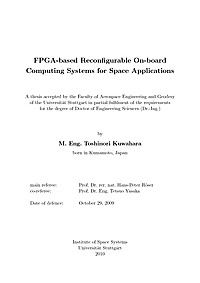
FPGA-based reconfigurable on-board computing systems for space applications
The purpose of the thesis is to conceptualize an application method of ground-based reconfigurable FPGA (Field Programmable Gate Array) technologies for space systems and to apply the method to the on-board computer of the small satellite Flying Laptop for the on-orbit demonstration. The Flying Laptop satellite is the first small satellite within the Stuttgart small satellite program'' in which several small satellites are developed by the Institute of Space Systems at the Universität Stuttgart. The main mission of the Flying Laptop is to demonstrate the space use of reconfigurable FPGAs for the reconfigurable computing'' on an central on-board computer aboard a spacecraft. Due to their radiation vulnerabilities reconfigurable FPGAs have not yet been employed in practical space applications with high reliability requirements. The Flying Laptop project aims to achieve the world's first orbit demonstration of a purely FPGA-based central on-board computer. Within this research firstly, application methods of reconfigurable FPGAs for space systems were investigated, which are not limited to small satellites but for general space systems. The investigation is based on thorough experimental data survey and analysis of radiation effects on existing FPGA devices. Main radiation effects of single event effects and total ionizing dose effects were extensively investigated. Based on the data obtained, a combinational use of SRAM-FPGAs (multi-chip redundant) and Flash-FPGAs (voting element) for mitigating radiation effects was conceptualized. A mathematical system reliability analysis of repairable multi-redundant systems has been. The analysis illustrates that a multi-redundant system based on SRAM-FPGAs together with a Flash-FPGA based voter provides a sufficiently high reliability for Low Earth Orbit (LEO) missions against radiation effects. After the conceptualization of application methods of reconfigurable FPGAs for the space environment, it is applied to the on-board computer of the small satellite Flying Laptop. Flying Laptop is a cubic, 3-axis stabilized satellite with the edge lengths of about 600mm x 700mm x 800mm and a mass of about 120kg, which shall be launched into sun-synchronous LEO in an altitude of around 600km. A system architecture with four SRAM-FPGA based central processing nodes and one Flash-FPGA based voter was applied for the on-board computer of the Flying Laptop. This on-board computer is the central computing system aboard the satellite and shall be capable of controlling all satellite peripheral electronics. First of all, the system design of the whole satellite has been conducted within the scope of the thesis in order to allow the design of the on-board computer. Based on the established system requirements, the on-board computer of the Flying Laptop was designed and the breadboard model and partly the engineering model of its components are developed. The hardware logic (control algorithm) which shall be implemented into FPGAs can be designed by means of hardware description languages. However, it is no longer software engineering but hardware engineering for generating real hardware logics inside FPGAs which are executed in parallel in real-time. The satellite main functions are designed, developed, and implemented in FPGAs by means of the hardware description languages Handel-C and VHDL. The thesis provides development methods of the control algorithms. In addition to this, a control algorithm development facility has been established for the further design activities. Finally, the developed control algorithms are verified in a simulation and verification environment in order to prove the validities of the above described developments. First of all, an FPGA hardware-in-the-loop real-time simulation environment has been established based on the Model-based Development and Verification Environment (MDVE). MDVE was established at the Institute of Space Systems supported by EADS Astrium. The communication interface between the MDVE and FPGAs are developed, including the required hardware components and the serialization algorithms of communication lines inside an FPGA. Using this simulation and verification environment, extensive simulations have been conducted and the design of the on-board computer, as well as the system design of the whole satellite are validated. At the end, an extended investigation has been conducted on formal verification methods of the hardware-logic in order to provide the way of strict design verifications. This thesis establishes the basis of principle application methods of reconfigurable FPGA technologies for reconfigurable computing'' on space systems which provides innovative solutions for high computational demands of future space applications.



















